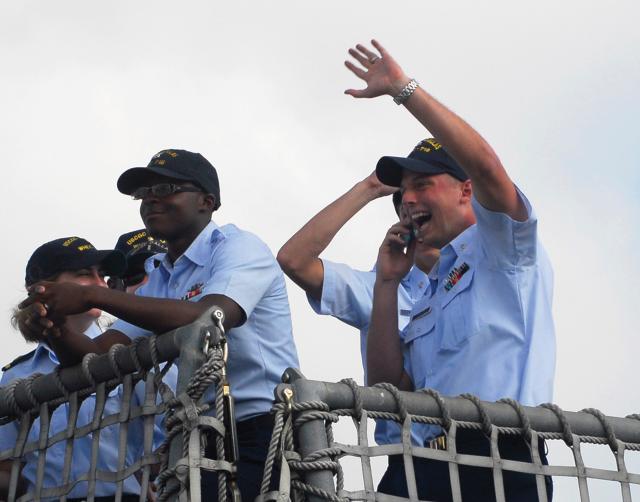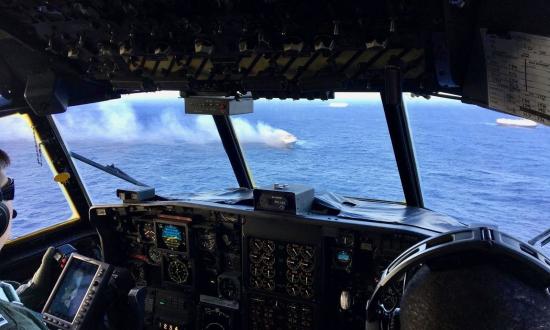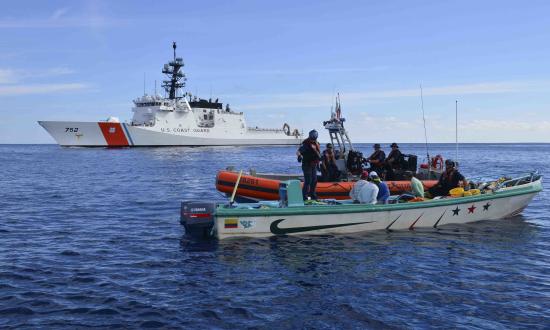Miles off the coast of New England, the Rita Mae rolls dangerously on her side, tossed about by the growing waves of a winter storm. A part in her engines has failed, and without a spare on board, her crew is at the mercy of the seas, unable to move toward her home port in the rapidly degrading conditions. Suddenly, a tiny spotlight cuts through the torrents of sleet and snow, and an unmanned aerial system (UAS) lowers the needed part, enabling the crew to complete repairs and return to port safely.
Meanwhile, in the Port of Long Beach, a marine inspector boards a merchant vessel to check a fire suppression system that has been targeted by an artificial intelligence (AI) system. Her tablet highlights troubling sensor data, training logs, and crew information that was pulled from the vessel’s systems while it was making its transit, marking it as a priority inspection over the other six inbound vessels headed to port that day.
At Coast Guard Headquarters, acquisition managers meet with health-care professionals to discuss injury data associated with the surfman program that has been consolidated from an AI review of health records. Their combined efforts result in design alterations for new assets that will prevent chronic injuries, ensuring future workforce resiliency.
While these might seem like futuristic scenes from Westworld, this technology exists today. The world is in the midst of the fourth industrial revolution, an era of exponential technological growth in which innovation and the application of emerging technologies are spurring unprecedented changes worldwide. The success of the Coast Guard during this period will not be determined solely by the incorporation of autonomous craft, effective use of big data, automation of routine processes, integration of sensors, or implementation of AI into boutique aspects of daily operations; it will require reimagining how the entire array of technologies can work together to transform the service, its processes, and its workforce.
According to Professor Klaus Schwab, author of The Fourth Industrial Revolution and Shaping the Fourth Industrial Revolution, the challenge any organization faces is not only keeping pace with the velocity with which technology is altering society, but also moving past linear thinking that hampers decision-makers’ ability “to think strategically about the forces of disruption and innovation shaping our future.”1
The Coast Guard’s “Tech Revolution” addresses the need to overcome 1990s-era hardware and a $300 million technology funding shortfall and will align the service with basic state-of-the-industry computing standards.2 However, it falls short of incorporating the technologies afforded by the fourth industrial revolution and is far from making the opening vignettes reality any time soon. The Coast Guard needs to accelerate its efforts to embrace emerging technologies to retain relevance against today’s peer-nation threats.
To do so, the service needs to embrace three fundamentally different mind-sets regarding the incorporation of technology. First, it needs to shift its acquisition mind-set from building a newer version of yesterday’s Coast Guard to reimagining effective and efficient mission accomplishment and selecting technologies that may be radically different from traditional, familiar practices.
Second, the service needs to think beyond the tactical applications of technology. This is difficult for an operationally minded service, but the Coast Guard must leverage technology to transform workforce management and workplace processes, building an organization that will attract tech-savvy individuals.
Third, the Coast Guard must move forward fearlessly, understanding and accepting that technology will fundamentally reshape the service, which may result in fewer personnel or a smaller footprint. However, rather than requiring it to do more with less, technology-driven re-allocations will present opportunities for the service to reinvest capabilities to best support homeland security and defense priorities.
In addition to these challenges, the Coast Guard seems perplexingly resistant to technological change. Cutters, for example, have had electronic navigation systems on board for more than 15 years, but it took the forcing function of the National Oceanic and Atmospheric Administration eliminating paper chart production before the service approved its first pilot program of paperless navigation on a cutter. This was four years after it reduced similar regulations for commercial vessels conducting domestic transits.
There have been notable bright spots, such as the now disestablished Group 1 UAS Prototype Program Initiative (GUPPI), which enabled field testing of new UAS technology while developing sustainable programs of record at headquarters. With a focus on imagery collection, UAS use—whether for pollution verification in the wake of a maritime accident or inspection of hard-to-reach aids to navigation—is proving to be the faster and cheaper way to do business.3 Bottom-up, field application of emerging technology is the type of agility needed to propel the service forward.
To sharpen its operational edge, the Coast Guard also needs to turn attention to resources such as AI. AI and its associated machine-learning processes enhance a human’s ability to approach challenges differently—for example, by identifying patterns in large data sets. QuantaVerse developed AI software able to recognize money laundering patterns without human oversight. In collaboration with an unnamed financial institution, AI reviewed years of data and was able to identify a drug-trafficking ring in Panama associated with duty-free stores by recognizing a previously unseen financial pattern. This led to an arrest by the Drug Enforcement Agency.4
Now, introduce that capability in the Coast Guard’s counterdrug mission. If AI were allowed to review the years of data within case packages of successful interdictions, what patterns could be extrapolated? How might those discoveries aid the identification and prosecution of transnational criminal organizations? What patterns could be discovered from operations that did not result in a successful interdiction that could be used to better target and interdict illicit contraband at sea? Suddenly, the service may find a wider array of intelligence-driven options at its disposal, rather than conducting yet another surge operation.
The Coast Guard’s natural tendency is to focus on tactical applications, but it must look inward to its workforce management processes and build a technologically capable workforce. Most of the service’s efforts within the “Tech Revolution” concentrate on cloud-based computing, digitization, and mobility solutions to enhance workforce productivity.5 The Coast Guard recently initiated integration efforts with a big-data platform; this effort shows significant promise by harnessing data to drive better workforce management and performance.
Stitch Fix is an online apparel company that leverages user data paired with the oversight of human stylists to deliver clothing items chosen for the user, not by the user. This is not a typical fashion company; it employs nearly 80 data scientists, building unique algorithms and proposing original solutions, such as analyzing the most effective physical footprint or developing and refining machine learning that understands a customer’s style preferences.6 The importance of algorithmic data incorporation cannot be overstated; in less than a decade in business, Stitch Fix had a net revenue of $1.6 billion in 2019.
Effective use of big data could completely restructure the Coast Guard’s assignment process. Each service member’s capabilities, personal needs, education, and experience, even hidden talents, could all be distilled to individualized data points. A true electronic military record would digitize the person, not just paperwork, and flip the assignment process on its head. Imagine if a service member were presented assignment options tailored from personal data points and designed to aid career progression, rather than having to filter through hundreds of potential assignments to find a good fit. The detailer still would play a vital role in the process, similar to the human stylists of Stitch Fix, with the ability to override the system for additional considerations. The potential increase in job satisfaction and productivity would be significant if the assignment system were designed with the continued development of the service member in mind, not just to fill a position with a qualified body.
In addition, integration of sensors could aid workforce management through enhanced health monitoring. Kinsa Health was able to build predictive mapping of the spread of COVID-19 using sensor data from its internet-connected thermometers; its flu season predictions typically are two to three weeks ahead of the Center for Disease Control and Prevention.7 In similar fashion, the Coast Guard could use sensors such as Fitbits to monitor service member health instead of annual periodic assessments. It could incorporate that data as an alternative to semiannual weigh-ins and fitness tests, saving time and resources and gaining a better understanding of workforce health. In turn, that data could be used to tailor health solutions to various operational communities based on trend analysis, enhancing workforce resilience.
Additional workforce management improvements will come from a focus on data capture, automation, and improved user interfaces. Technology can make many tasks service members perform easier. Unfortunately, the Coast Guard consistently accepts the low-rent option—members hand jamming data into Excel spreadsheets—most recently highlighted by numerous data calls using this method throughout the initial COVID-19 response. Relying on individuals to integrate data rather than incorporating automation is the more time-consuming and expensive option. The service did take significant strides with a consolidated big-data-driven reporting system with the COVID-19 vaccination process, which shows promise for the future. However, the lack of automated reporting processes for understanding the service’s readiness and the continued overreliance on people to consolidate data from its approximately 115 separate applications (most of which do not communicate with each other) is bewildering.
Rudimentary data-gathering processes and inefficient silos of data are not just poor data management; they are frustrating obstacles to the newer generations in and entering the workforce. Millennials are the first generation of digital natives; oftentimes, their personal phones provide more effective and efficient computing capability than they have access to in their workplace. The Coast Guard’s current tech environment is ill suited to attract and retain the technologically proficient workforce necessary to lead the service forward and highlights the need for a cultural shift to embrace technology in a different manner.
The most successful companies are not procuring task-specific tools, but rather are investing in technology to enhance their workforce. They recognize and embrace the symbiotic relationship between humans and technology. Humans help technologies perform their tasks, such as by improving algorithms to better harness the power of data; in turn, these technologies amplify a human’s capability by rapidly processing and interpreting that data.8
No Silver Bullet
There is no silver bullet; no one technology will make the Coast Guard better able to complement its DoD brethren in the era of great power competition. It is the full range of these technologies employed in concert that will profoundly reshape the service.
For example, the Coast Guard uses the Marine Information for Safety and Law Enforcement program to capture information on all operations; it contains decades of historical data. In addition, the service has access to a wealth of data on shipping routes and port usage recorded through the Automated Identification System. The service could procure anonymized cell phone data as an additional sensor, with a focus on waterways and offshore traffic. Without human intervention to help understand potential relationships, AI would view this information simply as three separate databases. Without AI, a human would be unable to identify correlations among the billions of data points within these three catalogs. However, working in tandem, the human and AI have the capability to categorize and visually depict this data. Gaining a better understanding of waterway usage in this way might alter the service’s force laydown or raise questions about the effectiveness of the service’s recreational boating safety program. Technology not only will enhance service capabilities through the use of new unmanned assets, but also could reshape the footprint of the service.
There is a natural apprehension about technological advances leading to the elimination of jobs or even workplaces, but rather than a drawback, this presents a reinvestment opportunity for the Coast Guard. For example, if instead of requiring an offshore cutter as a standby search-and-rescue asset, onshore UASs were available to assist mariners, that cutter and her crew would be free to combat transnational criminal organizations and counter Chinese influence within U.S. Southern Command. Billets reduced through the automation of routine administrative processes could be reallocated to grow the service’s ever-expanding cohort of cyber operators. Just as the service no longer hauls rowboats into the surf to conduct a rescue or patrols offshore to act as a weather station, it will continue to adapt its role in response to technological changes.
The post–fourth industrial revolution Coast Guard may be leaner but more efficient through the incorporation of emerging technology. The path toward that future will be one of upheaval and disruption, as traditional skills are challenged and changed, but the service must press on, with imaginative and fearless leaders guiding the way. Incremental adaptation will lead the Coast Guard into technological obscurity, reduced to an irrelevant and unreliable partner in an era of great power competition. Charging headfirst into the stormfront of the fourth industrial revolution, in keeping with the Coast Guard ethos, will drive the service forward as an efficient, capable partner ready to augment its Department of Defense peers with a skilled workforce enhanced by advanced technologies and ready to respond.
1. Klaus Schwab, “The Fourth Industrial Revolution: What It Means and How to Respond,” World Economic Forum, 14 January 2016.
2. Connie Lee, “Coast Guard Pursuing Ambitious ‘Tech Revolution,’” National Defense, 24 April 2020.
3. Craig Collins, “Coast Guard Short-Range UAS Do Yeoman’s Work,” Defense Media Network, 14 January 2019.
4. Issie Lapowsky, “Banks Deploy AI to Cut Off Terrorists’ Funding,” Wired, 10 July 2017.
5. U.S. Coast Guard, “Tech Revolution: Vision for the Future.”
6. Katrina Lake, “Stitch Fix’s CEO on Selling Personal Style to the Mass Market,” Harvard Business Review (May-June 2018).
7. D. G. Mcneil, “Restrictions Are Slowing Coronavirus Infections, New Data Suggest,” The New York Times, 31 March 2020.
8. Paul R. Daugherty and H. James Wilson, Human + Machine: Reimagining Work in the Age of AI (Boston: Harvard Business Review Press, 2018).









